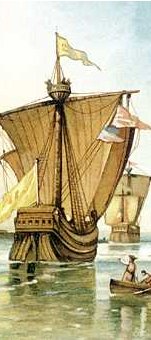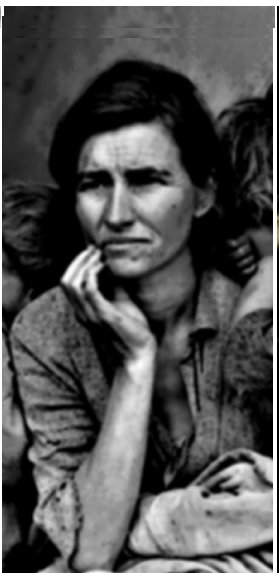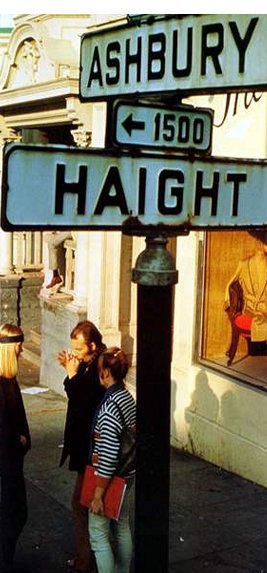Monterey: The Unknown Past Kyle So
Augusta Fink is a graduate from UCLA with a Master of Arts
degree in history. Although living in New York City, she
has lived in California for most
of her life. She has also previously lived in Carmel which
inspired many of the books she has written that tell about the heritage and
past of California. In addition,
she is a chairman of the history committee of the Monterey
history and Art Association.
The United
States has gone through many events that are
well-known among people. Some famous incidents in the United
States include the colonization of the California
territory by the Spanish Empire, the ceding of California
to the United States, the start of the
California Gold Rush, and the establishment of Los Angeles.
However, the discovery and history of Monterey
is more obscure. In Monterey: The Presence of the Past, author Augusta
Fink discusses the history and people of Monterey, whom
she believes ¡§represent the best of what is left of California¡¦s
splendid heritage.¡¨1
Monterey
lies along the Pacific coast of central California,
occupying ¡§3,324 square miles, or more than two million acres of land.¡¨2 The
area was first occupied by the Indians who moved to central California
because of its satisfactory climate. Shortly after they settled the land,
Spanish explorers led by Father Junipero Serra came in search of gold and land.
Soon enough, settlers from Mexico,
also called Californios, started occupying the land. Thereafter, the Americans
took control over Monterey and started transforming the land into one of
agriculture, constructed railroads through the territory, and developed resorts
and hotels along its coast which were surveyed into ¡§paper towns,¡¨ which were
basically large tracts of land that were used for construction of
resorts/hotels. The Native Americans that occupied the region of present day Monterey
County were composed of three
different tribes: the Costanoans, the Esselens, and the Salinans. The three
tribes settled the land for several decades but were soon after conquered and
massacred by Juan Rodriguez Cabrillo, a Portuguese explorer. Cabrillo then
became an important figure in the expeditions and conquests of central California,
beginning when he was sent by Pedro de Alvarado to explore the rest of the
Pacific. On his voyage, he was able to discover the San Miguel port, San
Salvador Island, Cape
Galera, San Miguel
Island, and Point Pino. However, due to gangrene
in Cabrillo¡¦s arm, he died on January
3, 1543. Later on May 5,
1602, Sebastian Vizcaino led an expedition with the purpose of
surveying the coast of California.
Following Cabrillo¡¦s previous route, Vizcaino founded Santa Catalina, San
Pedro, and lastly, Monterey. The
King of Spain, Charles III, appointed Father Junipero Serra as president of the
fourteen friars sent to Christendom. In 1749, missionaries, including Serra,
Palou, and Crespi, were sent to the College of San
Fernando in Mexico City
to learn the Pame language to preach to the American Indians. During his second
year in Mexico, Serra was appointed
president of the five Sierra Gorda missions in Mexico.
Throughout the years, he was sent to many places in south and central Mexico,
until July 1767, when he received his call to California.
Junipero Serra was then elected to take over the Jesuit missions in Baja
California. During that time, Russia
was moving south to occupy the port
of Monterey. In response to this,
Jose de Galvez, the new governor of Spain,
planned to consolidate the northwestern frontier and combine it into Alta
California. Through
expeditions by land and sea, Galvez colonized Alta California
by converting the Indians into Christianity. On July 1, The San Carlos and San
Antonio ships reached the harbor. The land expedition
traveled through San Juan Capistrano, the Santa
Ana River, the Santa
Lucia Mountains, the Santa
Rosa Creek, the San Carpoforo Creek/Canyon, the Nancimiento
River, and the Salinas
River. At that point, they realized
that the Bay of Monterey
was not where they had hoped. They then made the decision to continue northward
up until San Francisco Bay, where they were forced to turn
back to San Diego. After six months
of traveling over a thousand miles, the expedition came to the conclusion that
the port they were looking for did not exist.
At
San Diego, the San Antonio
ship dropped off supplies and the settlement was secured. Shortly after, Father
Crespi and his partner Portola, continued their expedition and reached Monterey
Bay on May 24. Celebrating their
discovery of the land, Portola took formal possession of it under King Charles
III of Spain.
Shortly after, the mission and presidio of Monterey
were established. During the construction of the new site, Serra went to the
Valley of the Oaks where he established the Mission San Antonio de Padua and
tried converting Indians to the Christian faith. However, during Serra¡¦s
absence, the settlement at Monterey
suffered extreme hardships and faced many problems. Months later, the ship Santiago
reached Monterey with fresh
supplies and provisions. Because the government of Mexico
wanted to expand the settlements in Alta California,
they regularly encouraged families to move there. In 1776, Monterey
was named the capital of Baja and Alta California. On
August 1784, Serra died in his sleep. By this time, Monterey
had a prosperous fur trade with Canton
which expanded Spanish trade and increased their treasury. However, supplies
and funds to Monterey were
ultimately stopped due to events in other places. On April 11, 1821, Mexico
won independence from Spain.
That same year, entrepreneurs by the name of Hugh McCulloch and William
Hartnell entered a partnership and established a firm to trade along the coast
of California. They established
stations along the coast to collect and trade hides and made Monterey
their headquarters because it offered social intercourse and contact with the
outside world. However, in 1828, the firm of McCulloch, Hartnell, and Company
disbanded, and the total losses for the firm totaled around $29,000. The next
year, government officials learned that Joaquin Solis, an ex-convict from Mexico,
had rallied soldiers and led them to revolt. Monterey
was at unrest and as a result, Lieutenant Colonel Manuel Victoria replaced
Echeandia as governor. However, Echeandia and Solis¡¦s radicals joined together
and plotted revolution. On November 1831, the radicals fought with Victoria¡¦s
soldiers and eventually secured a victory. Shortly after, Pio Pico, a radical
leader, was elected as a temporary governor. In January 1833, Jose Figueroa
replaced Zamorano and granted amnesty to all people who took part in the
rebellions, gaining popularity among the people. Unfortunately, his fame was
short lived when he died on September
29, 1835 due to apoplectic stroke. On November 3, 1836, Mariano Vallejo and Jose Castro
assembled a force of rebels which advanced into Monterey.
The next day Jose Castro declared California a ¡§free and
sovereign state,¡¨ and Alvarado was elected governor, while Vallejo
was appointed commander general. 3 On October 20, 1842, two American warships landed in Monterey
Bay, containing a large force of
American troops led by Commodore Thomas ap Catesby Jones, the Commander of the
United States Squadron in the Pacific. Upon arriving, he informed the people of
Monterey that the United States
and Mexico were at war, and that he
and his forces were ordered to take possession of California.
However, on that same day, he restored Monterey to Mexico
because two men named Larkin and Hartnell proved that Mexico
and the United States were NOT at war
during that time by showing him the latest communications from Mexico
and the United States.
On February 20, 1843,
Alvarado and Sutter¡¦s soldiers engaged in battle in the San Fernando Valley,
but in the end Sutter¡¦s forces withdrew and Micheltorena capitulated and left
for Monterey. In the end, Pio Pico
became the new governor and designated Los Angeles
as the new capital.
At
around the same time of the establishment of the new capital, James K. Polk
became the new president of the United States,
and as an expansionist, he wanted to acquire the province
of California. During March, a
discussion was held between the merchants, the military, and Vallejo
regarding the future of California.
Recognizing that California could not maintain its
independence based on its current resources, they concluded that the government
must break away from Mexico and become
annexed by the United States.
On May 1846, Polk and Congress declared war on Mexico
over Texan boundaries. On July 2, Commodore Sloat informed Larkin that he was
ordered to seize the ports of California
if hostilities started. Five days later, Sloat and several officers demanded
the surrender of the port, and declared California a
part of the United States.
Forty-eight members of a convention traveled to Monterey
to discuss the stability and policies of the state. Their first major issue was
whether to consider the government that of a state or territory, in which the
majority voted state. The second issue was slavery and it was determined that
¡§neither slavery no involuntary servitude, unless for the punishment of crimes,
shall ever be tolerated in this state.¡¨4 Their final issue was the
location of its eastern boundary, which remained unchanged. By October, Monterey
entered an era of optimism and prosperity from the gold fever in San
Francisco. But when the first state legislature met on
December 15, 1849, Monterey
was no longer the capital of California.
Monterey fell to political and
economical instability and lost its status as a city by 1853 due to the actions
of the legislature. By 1859, Monterey
was poor and had only one industry: shore whaling. As a result of its many
continual problems, Monterey was
called the ¡§Sleepy Hollow of California.¡¨5 Eventually, Monterey
found another industry which helped boost its economy: the sardine industry.
With this, Monterey rose to the
third largest fish tonnage port in the world, and by 1939 its industry payroll
was more than four million dollars. Yet another addition to Monterey
was Pacific Grove. It first started
as a summer camp and setting for church meetings, but on June 1, 1875, the Pacific Grove Retreat
Association was established. During the 1880¡¦s, the Pacific Grove became a site
of real estate development starting with the Del Monte Hotel, and by July 1889,
Pacific Grove became a sixth class city. South of the Carmel
River, lies the South coast shoreline of California,
70 miles on the seaward side of Monterey
County. In this region, government
survey took place to aid in the business part of the Partington enterprise.
Moreover, gold was sighted in the area first in 1848, but mining did not become
serious until 1876. It was not until the 1880s that California
became involved in its first real estate boom. Because many people were aware
of the potential of incoming immigrants, they bought real estate for cheap and
surveyed them into ¡§paper towns.¡¨6 However, due to undesirable
commercial ventures, a city planning commission was established to protect Carmel
from them in 1922. In present day Monterey,
the accelerated developments on the coast led to the pollution of the inner
valley, and owners of large pieces of land cannot preserve them, resulting in
prohibitive tax burdens. Without change, these problems will continue to
worsen, and so in response to these problems, Fink states that, industrial and
major residential development should be concentrated midway up the valleys and
to permit to public purchase of open space. With these changes, she hopes that Monterey
will maintain its splendored image and keep what is left of California¡¦s
history.
There
were many things in the United States
that influenced and changed California.
Some events in the Eastern United States that influenced California
were creation of the railroad expansions (Southern Pacific Railroad), the idea
of westward expansion, the Mexican-American War, and the Gold Rush. The
railroad expansion influenced California
in that it allowed it to build tracks throughout the country linking many
states together and providing a fast and reliable source of transportation and
communication. The ideas of westward expansion also influenced California
because it brought about many settlers into California
from the East. A really important event that affected California
was the Mexican-American War. It was extremely significant because it was the
main factor in ceding California to the United
States when Commodore Sloat declared ¡§¡KCalifornia
will be a portion of the United States,
and its peaceful inhabitants will enjoy the same rights and privileges they now
enjoy.¡¨7 Lastly, The Gold Rush influenced California
because it was one of the factors of westward expansion, bringing a large
amount of people to California.
Some of the things that occurred in California were
distinctive from the rest of the country because it was so isolated from the
rest of the United States
at the time. Because of that, California
was very different from those on the East Coast.
According
to Fink, she views Monterey, California
as important to the rest of the country because it played key roles in United
States history and its economy. As one of
the first states on the west coast, California linked the western and eastern
states, led to additional westward expansion, was the location of the Gold
Rush, a site of one of the richest soil in the United States, was previously a
capital of California, was a place of many resorts/hotels which led to a lot of
immigration, and it also played a role in boosting the county¡¦s economy with
its sardine industry which quickly ¡§rose to the position of third largest fish
tonnage port in the world.¡¨8
Fink¡¦s
reason for explaining this topic was to provide insight into the infamous
history of Monterey. Fink¡¦s
thoughts about Monterey were that it was first used as a
course of religious events from Father Serra¡¦s expedition, to a site of resorts
and immigration, and then as part of the United
States where its economy gradually rose. She
explains how Monterey was first
settled upon by ¡§Indians, conquistadors, missionaries, Yankee traders, and
bohemians,¡¨ and the events leading to the present-day county. 9 In
addition, she talks about the important people who played a part in Monterey¡¦s
history such as Governor Riley, Commodore Thomas Catesby Jones, Commodore
Sloat, Cabrillo, Vizcaino, Father Junipero Serra, Jose de Galvez, and many
more. Lastly, she reveals many unknown facts about the city that many people do
not know such as the development of the ¡§paper towns,¡¨ its establishment as a
capital, its nickname ¡§Sleepy Hollow of California.¡¨
Fink,
although a local of New York City, has lived in California
for most of her life. She graduated from UCLA with a Master of the Arts degree
in history; and strives to, ¡§bring fully alive both the romance and reality of California¡¦s
rich historical heritage.¡¨10 Her views are often based on western
history and California. She talks
often about California¡¦s culture and heritage and is
also a part of the history committee of the Monterey
history and Art Association which is dedicated to preserving and promoting the
artistic and physical resources of Monterey.
Lastly, her writings are that of a New Leftist.
In
Augusta Fink¡¦s book, she goes over what went on throughout California
and Monterey¡¦s history. Her book
contains very detailed, accurate, and sensible facts that describe Monterey.
Even containing future problems that can occur such as the ¡§accelerated
development along the coast will inevitably lead to the interior valleys being
socked in with smog.¡¨11 Lastly, she is able to describe multiple
views of life in Monterey in view
of Indians, conquistadors, entrepreneurs, etc.
From
the Indians to the Entrepreneurs, Augusta Fink talks about the many people that
occupied Monterey and the events
that took place in that location. She reveals these facts to people to let
people know how Monterey was like in the past, with the
ultimate hope that ¡§the will and the way will be found to protect the
many-splendored image of Monterey.¡¨12
1. Fink, Augusta. Monterey: The Presence of the Past. San Francisco: Chronicle Books, 1972.
2. Fink, Augusta 8.
3. Fink, Augusta 73.
4. Fink, Augusta 116.
5. Fink, Augusta 126
6. Fink, Augusta 220.
7. Fink, Augusta
88-89.
8. Fink, Augusta 133.
9. Fink, Augusta 1.
10. Fink, Augusta
255.
11. Fink, Augusta
249.
12. Fink, Augusta
250.





















